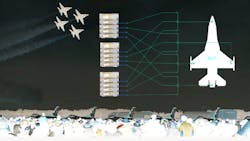Electronic-warfare (EW) systems must be characterized with realistic test signals but creating such simulation signals is usually not routine. The signals are often generated by a system with multiple waveform generators and modulation sources operating over the frequency range of interest. It is possible to do without a room full of test equipment, but doing so requires some amount of understanding about the types of test signals needed for EW system simulations. Fortunately, a 20-page application note recently released by Keysight Technologies, “Electronic Warfare Signal Generation: Technologies and Methods,” examines the different technologies for generating EW test signals as well as the hardware and software options for controlling those signals.
An EW receiver typically has the broad bandwidth and wide dynamic range to gain an awareness of the highly modulated signals used in EW systems, typically with amplitude modulation (AM), frequency modulation (FM), and pulse modulation (PM). The signals of interest must be extracted from surrounding EW signals and commercial systems across a wide bandwidth, such as 2 to 18 GHz. Generating such complex signals has traditionally required multiple analog RF/microwave signal generators and modulation sources, although newer, digital signal-generation techniques are providing some of the advanced signals for EW testing at reduced size, weight, and power (SWaP) in keeping with modern military requirements. To accurately emulate the EW system operating, any test signal solution should also be capable of producing the commercial signal components that are typically part of that signal environment, and this 20-page application note explores how to re-create advanced RF/microwave signal environments while trimming SWaP and cost compared to traditional approaches.
EW receivers are not becoming any simpler as the signal environments in which they operate become denser with different types of modulated signals. But they, and the signal generators that can simulate their operation, are becoming smaller and more complex and this concise and highly informative application note provides practical guidance on generating the test signals needed to accurately exercise modern EW systems.
Copies of the application note are available for free download in PDF file format from the company’s website.
About the Author
Jack Browne
Technical Contributor
Jack Browne, Technical Contributor, has worked in technical publishing for over 30 years. He managed the content and production of three technical journals while at the American Institute of Physics, including Medical Physics and the Journal of Vacuum Science & Technology. He has been a Publisher and Editor for Penton Media, started the firm’s Wireless Symposium & Exhibition trade show in 1993, and currently serves as Technical Contributor for that company's Microwaves & RF magazine. Browne, who holds a BS in Mathematics from City College of New York and BA degrees in English and Philosophy from Fordham University, is a member of the IEEE.
